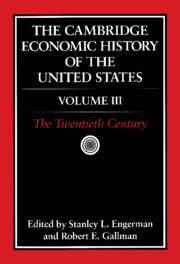Book contents
- Frontmatter
- 1 American Macroeconomic Growth in the Era of Knowledge-Based Progress: The Long-Run Perspective
- 2 Structural Changes: Regional and Urban
- 3 Twentieth-Century Canadian Economic History
- 4 The Twentieth-Century Record of Inequality and Poverty in the United States
- 5 The Great Depression
- 6 War and the American Economy in the Twentieth Century
- 7 U.S. Foreign Trade and Trade Policy in the Twentieth Century
- 8 U.S. Foreign Financial Relations in the Twentieth Century
- 9 Twentieth-Century American Population Growth
- 10 Labor Markets in the Twentieth Century
- 11 Labor Law
- 12 The Transformation of Northern Agriculture, 1910–1990
- 13 Banking and Finance in the Twentieth Century
- 14 Twentieth-Century Technological Change
- 15 The U.S. Corporate Economy in the Twentieth Century
- 16 Government Regulation of Business
- 17 The Public Sector
- Bibliographic Essays
- Index
- References
6 - War and the American Economy in the Twentieth Century
Published online by Cambridge University Press: 28 March 2008
- Frontmatter
- 1 American Macroeconomic Growth in the Era of Knowledge-Based Progress: The Long-Run Perspective
- 2 Structural Changes: Regional and Urban
- 3 Twentieth-Century Canadian Economic History
- 4 The Twentieth-Century Record of Inequality and Poverty in the United States
- 5 The Great Depression
- 6 War and the American Economy in the Twentieth Century
- 7 U.S. Foreign Trade and Trade Policy in the Twentieth Century
- 8 U.S. Foreign Financial Relations in the Twentieth Century
- 9 Twentieth-Century American Population Growth
- 10 Labor Markets in the Twentieth Century
- 11 Labor Law
- 12 The Transformation of Northern Agriculture, 1910–1990
- 13 Banking and Finance in the Twentieth Century
- 14 Twentieth-Century Technological Change
- 15 The U.S. Corporate Economy in the Twentieth Century
- 16 Government Regulation of Business
- 17 The Public Sector
- Bibliographic Essays
- Index
- References
Summary
INTRODUCTION
On four occasions during the twentieth century major international confrontations led American society to shift substantial amounts of labor, capital, and technology from peacetime employments to production for national defense and international war: World War I, 1917–1918; World War II, 1941–1945; the Korean War, 1950–1953; and the Vietnam War, 1964–1973. Significant resources were also committed to national defense during the four decades of the Cold War, 1947–1989. With the exception of the Civil War, the typical nineteenth-century share of military expenditures in U.S. gross national output, expenditure, and income (hereafter GNP) was well below 1 percent. Conquering and pacifying the Western regions of the nation and defending the lengthening land and sea borders were the principal aims of nineteenth-century national security policy. U.S. foreign policy deliberately sought to insulate the nation from the international conflicts of the imperial European nations.
In the last quarter of the nineteenth century several factors began to change American national security policy. First, American overseas trade and investment interests expanded; as the last continental frontiers were settled, overseas economic opportunities gained attractiveness. Second, the major European powers expanded their imperial rule in Africa and Asia, areas where the United States heretofore had had relatively unfettered, though largely untapped, trade access. Finally, the major European powers became involved in a naval arms race. In the mid-1880s the U.S. Congress began to appropriate substantial funds for heavily armored and gunned naval vessels to patrol the Atlantic and Pacific Oceans thousands of miles off the North American shoreline.
- Type
- Chapter
- Information
- The Cambridge Economic History of the United States , pp. 329 - 406Publisher: Cambridge University PressPrint publication year: 2000
References
- 9
- Cited by



